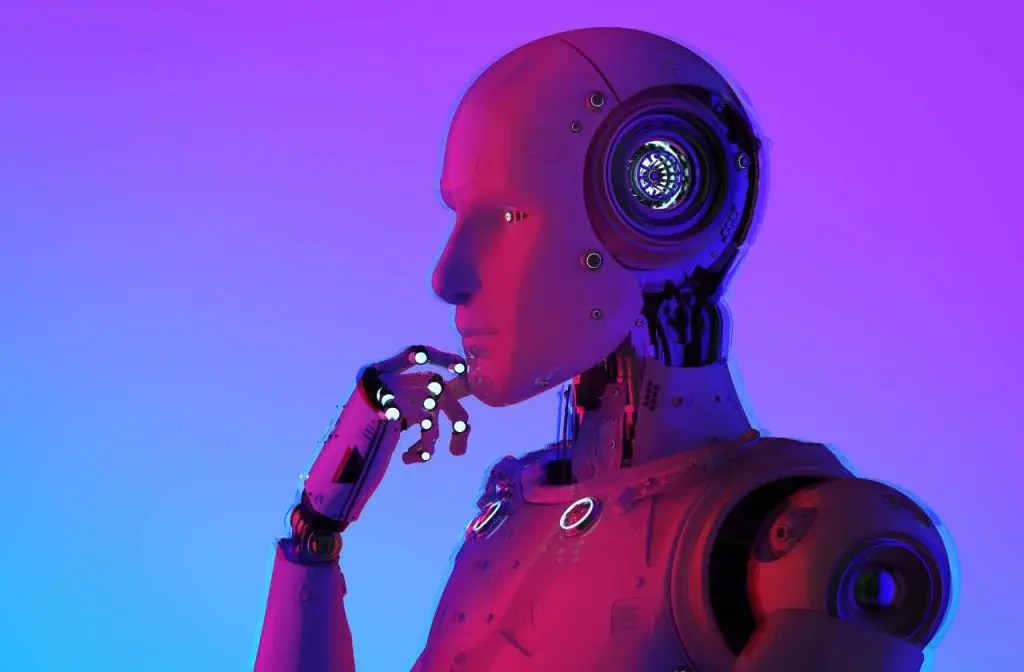Let us take a look at what Artificial Intelligence is, today, pros and cons in 2023 of these advanced technologies that we must now consider an integral part of our daily lives, in light of the upheavals they are bringing and the future prospects they portend.
To be sure, artificial intelligence is radically transforming society and the economy, and in the years to come it will do so more and more as its applications expand and its capabilities improve. But in addition to the advantages that such an evolution portends, one must also consider the other side of the coin.
On the one hand, AI promises to improve many aspects of our lives. Just to give a few examples, it can analyze huge amounts of data to make more accurate medical diagnoses, it can make financial predictions, it can optimize manufacturing processes, and in many other areas. Robots and autonomous vehicles can perform risky and repetitive tasks for us, improving safety. Virtual assistants can make life at home smarter and more monitored, keeping us connected to the information we need.
On the other hand, however, AI raises concerns and questions. Evolutions in machine learning and neural networks could lead to systems that are beyond human control, becoming far too autonomous. What would happen then? Fiction and filmography have always created an unsettling storytelling around this issue, drawing our attention with the myth of the robot that can transform into something very destructive.
AI: What’s going on
Artificial Intelligence is a long-standing chapter, actually, because it began to develop from the 1950s with pioneers such as Alan Turing and John McCarthy who laid the theoretical foundations.
Over the years it has developed in many forms, coming out in epic fashion in 2022 with the face of a technology that is nothing short of revolutionary, the Chat GPT chatbot. Today, AI is one of the biggest trends driving the digital transformation of businesses.
Well, however, this enormous change has raised ethical and social questions that, in a mix of amazement, excitement and skepticism, is raising the potential risks that need to be addressed: from privacy to data security, from the automation of some tasks that puts professions and jobs at risk to the even worse devaluation of critical thinking and the human intellect’s own ability to research, create and distinguish.
These are the most relevant and concrete aspects of the issue, but many others are prophesied, portending scenarios à la Asimov, just to name a few, the famous Russian-born, naturalized U.S. writer and professor of biochemistry who is considered one of the greatest science fiction authors of the 20th century.
Asimov explores the various aspects of artificial intelligence, highlighting its enormous potential but also its ethical problems and underlying implications for human society.
So, there is a general consensus that there is a strongly perceived need to develop regulations such as to ensure the responsible use of Artificial Intelligence technologies, especially in an inclusive and non-discriminatory manner, for the benefit of all.
What is Artificial Intelligence
It is the new era of information technology, in which algorithms and data are the masters, feeding machines by making them capable of processing information.
Artificial Intelligence is the technology that is now capable of performing activities that were once the exclusive intellectual and practical domain of humans.
In a nutshell, AI includes a number of advanced techniques and technologies that enable machines to process data by mimicking human cognitive abilities, and to perform even more complex tasks.
AI creates algorithms and models that enable computers to learn and represent knowledge, reason, process natural language, perform movements, and make decisions autonomously, similar to human thinking. There are two main categories within which to classify Artificial Intelligence: weak AI and strong AI.
1. Weak (or limited) AI: defines those systems designed to perform a specific task, such as voice recognition or customer service via a chatbot; they respond only to input in preprogrammed or learned ways. An example of such a system is Apple’s Siri or Alexa.
2. Strong (or general) AI: defines those systems that possess a form of awareness and understanding, capable of performing any intellectual task on par with a human being, with a theoretical but prophesied “autonomy of thought.”
Approaches in this discipline also include Machine Learning which allows computers to learn from data and improve performance over time, and Deep Learning, which uses artificial neural networks capable of mimicking the functioning of neurons in the human brain for machine learning.
In essence, these systems are able to learn and improve performance based on data, without being programmed to do so.
In particular, Deep Learning is revolutionizing many industries by helping to create virtual assistants, chatbots and voice recognition systems.
With the evolution of deep learning techniques, AI is able to learn from the data and contexts in which it is involved. Future improvements in neural networks and learning techniques will lead to more even more sophisticated AI systems capable of solving increasingly complex problems.
In what areas artificial intelligence can be applied
Because of its power and versatility, AI can be used in a variety of fields and industries, all of which are characterized by the possibility of accurate and deep data analysis, i.e., from medicine to finance for forecasting market movements; from manufacturing to transportation and handling; from politics to social sciences and humanities; from marketing to sales and customer service to content creation and advertising materials.
AI has also penetrated the military to perform various military tasks, such as surveillance, targeting, combat operations support, and explosive device removal. Drones, in particular, are used for reconnaissance, patrol and targeted strike missions. These devices are capable of operating autonomously or semi-autonomously, analyzing data in real time and adapting to battlefield situations.
But without going too far, for a view closer to the everyday, think of everything we experience every day when we use the various devices to navigate between social, google, maps, when we query virtual assistants.
We haven’t covered all the areas that can be manned by AI, but it is allowed to span the seas and mountains… As its capabilities continue to improve, AI will have a significant impact on society and the economy globally.
Benefits and risks of artificial intelligence

Pros: Increased productivity and reduced human error
In the work environment, automation of many tasks and processes is an advantage for several reasons:
- The increased efficiency and productivity given by machines that can perform tasks without interruption, 24H, without ever giving in to distraction or fatigue.
- the drastic reduction of human error by being able to program machines to perform certain tasks based on information gathered in algorithms.
Cons: Loss of jobs
However, this ability for trained machines to be present (and meddle) to replace people may cause job losses in some areas and the need for training and retraining in others. Many roles could be replaced by robots and algorithms.
Pros: Data analysis
AI can process huge amounts of data at an impressive rate. This can come in handy in areas such as healthcare or finance, where AI can analyze medical documents and records or diagnostic images todetect anomalies or predict health risks.
Cons: Data breach
On the other hand, however, the very ability to collect large amounts of data raises questions regarding the diffusion of sensitive information and the subsequent breach of it. In addition, there is a risk that AI may be used in discriminatory and unfair ways by those who come into possession of data and information.
Pros: Quick and informed decisions
Unlike the timing and decision-making motive of humans, AI-enabled machines are trained to make faster and more informed decisions based on data logic and algorithms, without succumbing to suggestions driven by emotionalism and psychological conditioning.
Cons: Loss of control and dehumanization
On the other hand, however, the risk of leaving decision-making power to intelligent machines is to reduce everything to preformatted schemes, dehumanizing and depriving of emotion and creativity areas where, instead, it is important to maintain the human, emotional, narrative touch.
Without adequate safety and control measures, artificial intelligence systems could become far too intelligent and powerful, escaping human control, and this could have unpredictable consequences. Suffice it to say that machines, acting according to programmable events have no knowledge of what is right or wrong.
Pros: Artificial intelligence can be used by anyone
We can all use AI by harnessing its benefits in different sectors and contexts, from smart homes where home automation transforms the everyday to the office or company.
Consider, as premised, personal assistants with (weak) artificial intelligence such as Siri or Alexa that respond to our questions and instructions.
Cons: Dependence on Technology
However, the penetration of AI into every cell of our experience may expose us to the danger, if not already becoming a reality, of increasing dependence on technology. With all that this loss of analytical and psychological autonomy entails.
Complete automation in every area of our existence could generate a feeling of emptiness or a kind of “indigestion,” manifested by unpredictable social phenomena.
AI: the benefits in the medical health sector
I think it is only fair to devote a paragraph to this in my view entirely positive aspect of Artificial Intelligence.
In healthcare, AI promises major new breakthroughs in terms of medical research, earlier and more personalized diagnosis, and innovative therapies. Virtual assistance systems can complement the work of doctors and nurses, train new profiles with artificial surgery simulators, advanced devices that help detect and manage neurological disorders to mimic brain function. Just to give examples.
To conclude,
it is important to assess all the pros and cons of Artificial Intelligence in 2023 and for the future, so that the positive and negative aspects can be managed. In order not to lose vision and control of the technology.
This control can be maintained through some fundamental steps:
- establish guidelines for AI development and implementation, as the European Union has already done by publishing Principles of Ethics for AI. All companies should adopt these principles and develop internal codes of conduct.
- Adopt learning systems that avoid any form of bias inoculated into data and algorithms, reminding us that AI learns from data. Human biases and forms of racism should not be integrated into AI systems.
- Carefully evaluate AI systems before putting them in the public domain in order to anticipate all possible side effects.
- Helping people to use AI ethically and judiciously, educating them to create in them the right awareness of all its implications.
- Human involvement. People must remain an integral part of the processes involved in AI. It is essential to maintain human supervision at all times.
Technology itself is neither good nor bad; its implication depends on how we use it.






